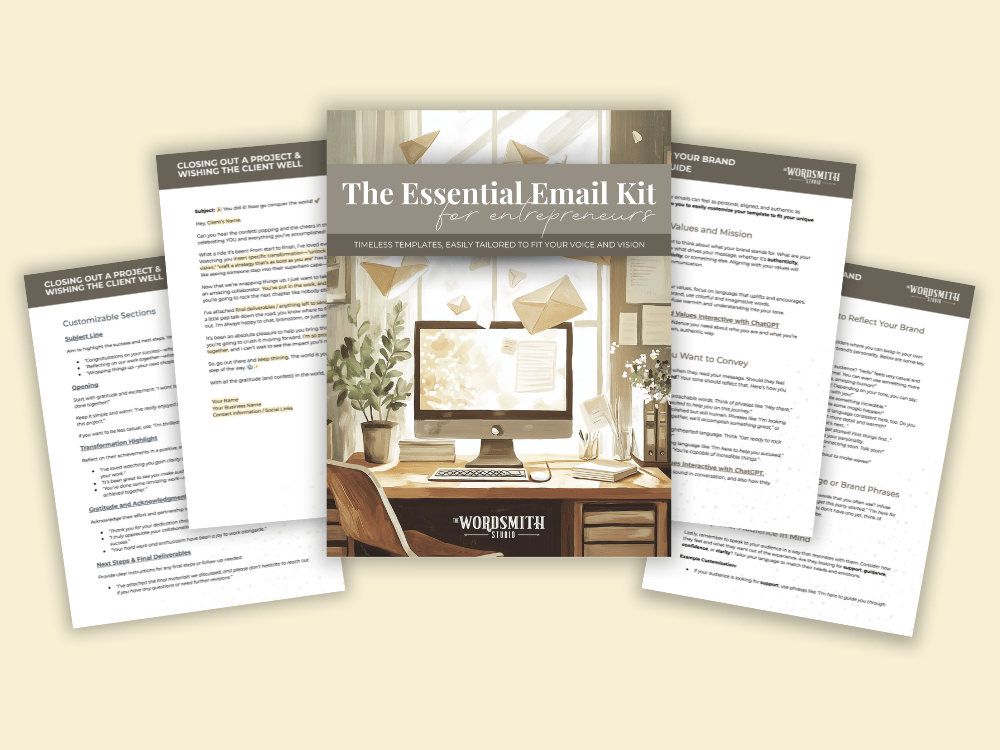Some days, writing flows like a dream. Other days, just stringing together a sentence feels like trying to thread a needle with oven mitts on. Writing when you’re tired feels impossible.
You’re exhausted. Or overloaded. Or managing one too many tabs (browser and brain included).
- You had back-to-back client calls and now your brain is oatmeal.
- You just got off a tough customer support email that rattled your energy.
- Your kid is sick (again), the dog won’t stop barking, and the only quiet time you have is during a 20-minute window between school drop-off and your next meeting.
- You know you should post something to Instagram, send a quick email, or finish that blog draft… but you’re staring at the blinking cursor like it personally offended you.
And yet, the content still needs writing. Or the caption. Or the client update. Hmmm. Or does it?
You can write valuable, on-brand content even when you’re not at your best—if you have the bandwidth to try.
But if your tank is empty, your brain is foggy, and you’re running on guilt and caffeine? Close the laptop. That’s not content—it’s a cry for rest.
This post is here for the days when you’ve got a little capacity left and want a way to work with your limitations, not against them.
Check In Before Writing
Before you push through “just one more thing,” pause and ask yourself:
- Am I physically or emotionally exhausted?
- Is this content actually urgent? Or could it wait?
- Will writing right now support me—or burn me out?
If you’re deep in decision fatigue, carrying invisible emotional labor, or already dragging from a 10-item to-do list:
👉 Please take the nap. Drink the tea. Scroll aimlessly for a bit without turning it into a “content idea.”
But if there’s a little part of you saying: “I’ve got about 25% in the tank, and I’d like to get this out into the world…” then we’re in the right place. Let’s keep going.
Use My “Good Enough” Writing Scale
Pick your energy level. Match your writing task. Move forward with clarity.
You don’t need to give the same effort to a quick client email as you would to a new sales page. Matching your output to your capacity is smart strategy, not slacking.
Here’s how to scale your writing to fit your energy—and what each level can actually look like in real life.
Level 1: Survival Writing
For the “I’m here, but barely” days.
Best for:
- Social media captions
- Casual newsletters
- Client follow-ups
- Community replies
Try this:
- Social post: “Today’s win: I didn’t ghost my business even though I really wanted to. If you’re in the ‘meh’ zone too, I see you.”
- Email: “Hey [Client Name], just wanted to check in and make sure you saw the file I sent over Monday. No rush—just giving it a nudge in case it got buried.”
- Template tweak: Reuse a testimonial request or scheduling reminder and personalize the greeting and closing. Done.
Add a soft sign-off if needed: “That’s all I’ve got today. Back soon, but resting first.”
Skip this level for:
- Sales pages
- Long blog posts
- Website rewrites

Level 2: Functional Flow
You’ve got a bit more mental space, and you want to use it well. Not peak energy, but you can get into a rhythm if you keep it structured and simple.
Best for:
- Blog posts
- Weekly newsletters
- Thoughtful social posts
- Website updates (non-launch)
Try this:
- Blog post intro: “Truth? Writing when you’re exhausted feels impossible. But sometimes, the only way out is through, gently, one sentence at a time. Here’s how I write even on my most scrambled-brain days.”
- Email: “This week, I almost skipped sending this note because I was so behind. But then I realized—I don’t have to be polished to be helpful. So here’s a quick idea I think you’ll love…”
- Social post: A three-line caption with a tip, short context, and a soft CTA: “Writing when you’re tired? Set a 7-minute timer and see what comes out. No pressure. Just progress.”
Keep structure tight: Hook → Insight → CTA
Batch in 10–15 minute chunks. No marathon writing sessions required.
Still not the best time for:
- Messaging overhauls
- High-stakes or high-emotion content
Level 3: Full Energy, Let’s Go
You slept. You ate. The planets aligned. You’re ready. This is the day for the big writing projects.
Perfect for:
- Sales pages
- Launch sequences
- Signature blog content
- Course descriptions
- Website rewrites
Try this:
- Sales page: You’re not just writing features—you’re storytelling, infusing emotion, testing multiple angles. You’ve got the mental room to edit with nuance and strategy.
- Blog post or lead magnet: Maybe you’re finally writing the big post about your framework. Or mapping out a multi-part email series. You’re thinking about future re-use and repurposing as you go.
- Evergreen page update: You’re revising your homepage or About page with intention, sitting with each line to make sure it still feels like you.
Take advantage of this time, but don’t assume this is the standard. Full-capacity writing days are rare and valuable. Use them… and honor when they’re not available.
Low-Energy Writing Tricks (That Might Work for You)
What works for one person won’t always work for another. These are real strategies I’ve used (or borrowed from brilliant friends) to help make writing feel doable when energy is low.
You don’t need to use all of them. Try what works. Skip what doesn’t. You’re the boss here.
The One-Line Wonder
What it is:
Write one sentence. That’s it. If you feel like writing more afterward—awesome. But if all you’ve got is one line? You still showed up.
Example:
- Email: “The topic I originally planned for this week felt too heavy, so here’s something simpler that’s been helping me lately…”
- Post: “I didn’t ghost my business today, and that’s the win.”
Sometimes writing one line makes room for the second. Sometimes it doesn’t. Both outcomes are valid.
(I have a book series by I use for this type of writing.
The 7-Minute Sprint
What it is:
Set a timer for 7 minutes. Write until it dings.
No editing. No overthinking. Just forward motion.
Example:
- Write a rough draft of an intro paragraph for your blog post
- Draft a reply to a client that’s been weighing on you
- Brainstorm three potential Instagram topics you can build on later
You can always go another round if it feels good—but stopping at 7 is enough.
The Copy/Paste Tweak
What it is:
Reuse something you’ve already written.
It might be from a past client email, a blog post, or even a note to a friend. Adjust the tone, swap a few words, and boom—it’s new content.
Example:
- Newsletter: Turn a comment from a client convo into a short story + insight
- Sales follow-up: Grab your go-to proposal check-in, update the name and next steps
- Social post: Repurpose a favorite line from a blog post that didn’t get enough love the first time
This isn’t “cheating”—it’s being efficient with what you’ve already created.
The Voice Note Hack (for my fellow talk-it-outers)
Okay, confession time: this one isn’t my favorite. My brain doesn’t quite work this way. I do better with my fingers on a keyboard. But some of my writer friends swear by it.
What it is:
Hit record on your phone or voice memo app. Talk out what you’re trying to write. Ramble. Then transcribe and shape later.
Example:
- Explain the “why” behind your new offer like you’re chatting with a friend
- Record a quick explanation of a client win, then turn it into a case study post
- Capture a strong opinion or insight in the moment (before it floats away)
Bonus tip: Otter.ai or Descript can help you turn voice into text, fast.
Final Thought: Show Up With What You’ve Got (and Know When to Step Back)
You are not a machine. You are not “falling behind.” You’re a human running a business—and sometimes, that means writing with one eye open and a lukewarm cup of coffee in hand.
Writing when you’re tired isn’t a flaw in your process—it is the process for most of us.
So here’s your permission slip:
- Show up with what you’ve got, even if it’s not your best day.
- Reuse, reduce, repurpose. (Environmental and emotional sustainability, yes?)
- And when your body or brain says “nope”—listen. Rest is productive, too.
Whether you write one sentence, one paragraph, or just open the doc and stare at it for a minute before deciding today’s not the day—you’re still showing up with intention. And that counts.
P.S. If email writing is one of those things that drains your energy fast, check out The Essential Email Kit—20+ customizable templates for the client stuff you always have to say (but don’t always have the brain space to write).
Think onboarding, scope creep, updates, and oopsies—all written with heart and ready to go when you’re not.






